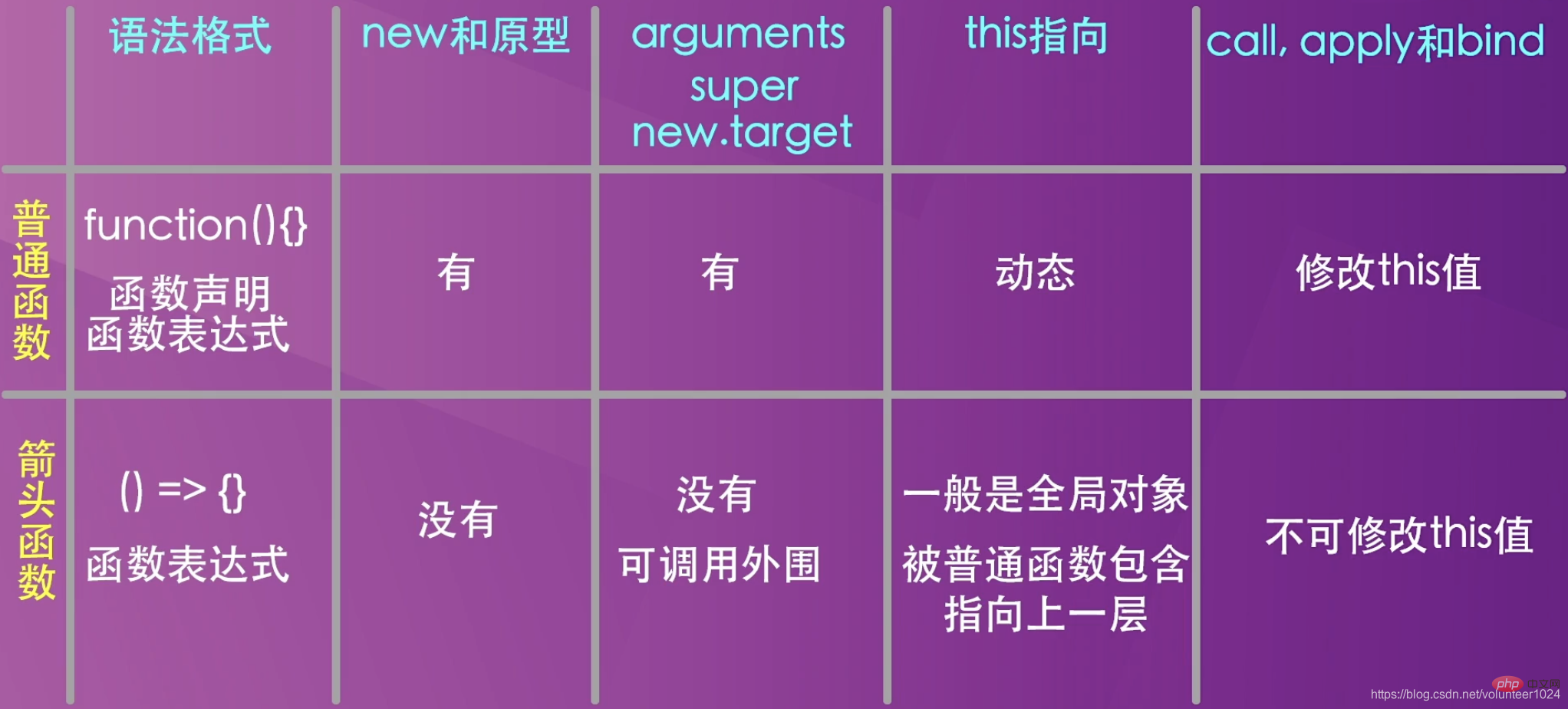本篇文章给大家带来了关于javascript的相关知识,其中主要介绍了箭头函数应用的相关问题,箭头函数表达式更适用于那些本来需要匿名函数的地方,并且它不能用作构造函数,下面一起来看一下,希望对大家有帮助。

【相关推荐:javascript视频教程、web前端】
箭头函数表达式的语法比函数表达式更简洁,并且没有自己的this,arguments,super或new.target。箭头函数表达式更适用于那些本来需要匿名函数的地方,并且它不能用作构造函数。 ---- MDN
(param1, param2, …, paramN) => { statements }
(param1, param2, …, paramN) => expression
//相当于:(param1, param2, …, paramN) =>{ return expression; }
// 当只有一个参数时,圆括号是可选的:
(singleParam) => { statements }
singleParam => { statements }
// 没有参数的函数应该写成一对圆括号。
() => { statements }let add1 = (num1, num2) => {
num1 + num2
};
let add2 = (num1, num2) => {
return num1 + num2
};
let add3 = (num1, num2) => (num1 + num2);
let add4 = (num1, num2) => num1 + num2;
console.log(add1(2, 3)); // undefined
console.log(add2(2, 3)); // 5
console.log(add3(2, 3)); // 5
console.log(add4(2, 3)); // 5//加括号的函数体返回对象字面量表达式:
let func = () => ({foo: 'bar'})
console.log(func()); // {foo: 'bar'}
//支持剩余参数和默认参数
(param1, param2, ...rest) => { statements }
(param1 = defaultValue1, param2, …, paramN = defaultValueN) => {
statements }
//同样支持参数列表解构
let f = ([a, b] = [1, 2], {x: c} = {x: a + b}) => a + b + c;
f(); // 6
why?语法更简洁,并且this更符合预期
如果函数逻辑相当复杂,应当使用命名函数
// bad[1, 2, 3].map(function (x) {
const y = x + 1;
return x * y;});// good[1, 2, 3].map((x) => {
const y = x + 1;
return x * y;});// bad
[1, 2, 3].map(number => {
const nextNumber = number + 1;
`A string containing the ${nextNumber}.`;
});
// good
[1, 2, 3].map(number => `A string containing the ${number}.`);
// good
[1, 2, 3].map((number) => {
const nextNumber = number + 1;
return `A string containing the ${nextNumber}.`;
});
// good
[1, 2, 3].map((number, index) => ({
[index]: number,
}));
// No implicit return with side effects
function foo(callback) {
const val = callback();
if (val === true) {
// Do something if callback returns true
}
}
let bool = false;
// bad
foo(() => bool = true);
// good
foo(() => {
bool = true;
});why?函数开头和结束更明确
// bad['get', 'post', 'put'].map(httpMethod => Object.prototype.hasOwnProperty.call( httpMagicObjectWithAVeryLongName, httpMethod, ));// good['get', 'post', 'put'].map(httpMethod => ( Object.prototype.hasOwnProperty.call( httpMagicObjectWithAVeryLongName, httpMethod, )));
// bad[1, 2, 3].map((x) => x * x);// good[1, 2, 3].map(x => x * x);// good[1, 2, 3].map(number => (
`A long string with the ${number}. It’s so long that we don’t want it to take up space on the .map line!`));// bad[1, 2, 3].map(x => {
const y = x + 1;
return x * y;});// good[1, 2, 3].map((x) => {
const y = x + 1;
return x * y;});// badconst itemHeight = item => item.height > 256 ? item.largeSize : item.smallSize;// badconst itemHeight = (item) => item.height > 256 ? item.largeSize : item.smallSize;// goodconst itemHeight = item => (item.height > 256 ? item.largeSize : item.smallSize);// goodconst itemHeight = (item) => {
const { height, largeSize, smallSize } = item;
return height > 256 ? largeSize : smallSize;箭头函数不能用new来创建构造函数的实例,普通函数可以(因为箭头函数创建的时候程序不会为它创建construct方法,也就是没有构造能力,用完就丢掉了,不像普通函数重复利用,因此也不需要构造函数原型,也就是不会自动生成prototype属性)
程序不会给箭头函数创建arguments对象
普通函数中的this是动态的,而箭头函数中的this指向的是紧紧包裹箭头函数的那个对象(定义时决定的)
箭头函数不能通过bind、call、apply来改变this的值,但依然可以调用这几个方法(只是this的值不受这几个方法控制)
【相关推荐:javascript视频教程、web前端】
以上是实例代码之ES6箭头函数实践的详细内容。更多信息请关注PHP中文网其他相关文章!